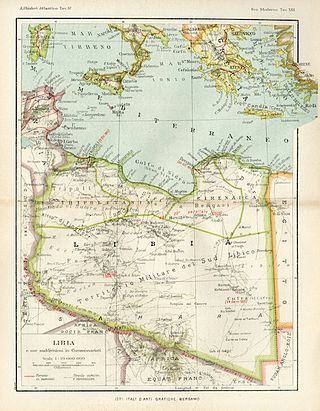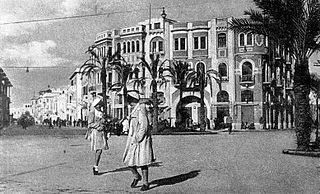

Italian Libya Railways was a group of railways built in the Italian colony of Libya between the two World Wars.


Italian Libya Railways was a group of railways built in the Italian colony of Libya between the two World Wars.
The Kingdom of Italy built in Italian Libya nearly 400 km of railways with 950 mm (3 ft 1+3⁄8 in) gauge. [1]
The Italian authorities decided to give priority to the construction of roads in Libya when Benito Mussolini took control of the Italian colonies. After 1926 no more railways were made in Libya, but during World War II the need of railways transport to the front during the war in the frontier with British Egypt changed this approach.
In spring 1941 the Italian government started the construction of a new railway between Tripoli [2] and Benghazi, but by the end of 1942 all was stopped because of the Italian defeat in north Africa: only 18 km were done in Cirenaica. [3] In the same period was started the enlargement of the "Tripoli-Zuara" until the border with Tunisia (and also these works was blocked by the Italian defeat at El Alamein in November 1942).
Additionally it is noteworthy to pinpoint that an international project was studied for decades, but never done because of excessive financial difficulties:
In Libya the first locomotives were the steam locomotives R.401 and R.301, but the most successful were the R.302 produced in northern Italy.
There were only five small railways:
1) Tripoli-Zuara (118 km):
| Stations | Central: Tripoli | 5 km: Gurgi | 6 km: Gargaresc | 16 km: Janzur | 22 km: Saliad | 30 km: Lemaia | 35 km: EtTuebiaGarg | 47 km: EzZauia | 56 km: EsSabriaBu-Isa | 64 km: Sorman | 76 km: SabrathaVulpia | 82 km: ZungaelAgelat | 100 km: Mellita | 118 km: Zuara |
|---|
2) Bengazi-Barce (108 km):
| Stations | Central: Bengazi | 9 km: Lete | 19 km: Benina | 30 km: Regima | 41 km: GabreGira | 49 km: BuMariam | 60 km: el-Abiar | 76 km: SidiMaius | 86 km: Sferi | 91 km: Sleaia | 97 km: SidiGibrin | 108 km: Barce |
|---|
3) Tripoli-Garian (90 km):
| Stations | Central: Tripoli | 5 km: Gurgi | 6 km: Gargaresc | 19 km: ElMisciasta | 24 km: EnNgila | 29 km: SuaniBenAdem | 35 km: BirElMiamin | 43 km: UmmelAdem | 50 km: ElAzizia | 83 km: HenscirElAbiat | 90 km: Vertice31 |
|---|
4) Bengasi-Soluch (56 km):
| Stations | Central: Bengazi | 1 km: Bengasi Porto | 2 km: Berca | 10 km: Guarscia | 14 km: GuarsciaBen | 24 km: Nauaghia | 32 km: NauaghiaB | 40 km: Giardina | 45 km: GiardinaVS | 50 km: SoluchFV | 56 km: Soluch |
|---|
5) Tripoli-Tagiura (21 km):
| Stations | Central: Tripoli | 2 km: Tripoli Riccardo | 3 km: Cavalleria | 5 km: SidiMessri | 9 km: Fornaci | 11 km: AinZara | 13 km: Sghedeida | 15 km: ElMellaha | 20 km: TagiuraFV | 21 km: Tagiura VS |
|---|

Misrata is a city in northwestern Libya located in the Misrata District, situated 187 km (116 mi) to the east of Tripoli and 825 km (513 mi) west of Benghazi on the Mediterranean coast near Cape Misrata. With a population of about 881,000, it is the third-largest city in Libya, after Tripoli and Benghazi. It is the capital city of the Misrata District and has been called the trade capital of Libya. The harbor is at Qasr Ahmad.

Zuwarah, Zuwara, or Zwara is a coastal city in north-western Libya.

The Italian colonizationof Libya began in 1911 and it lasted until 1943. The country, which was previously an Ottoman possession, was occupied by Italy in 1911 after the Italo-Turkish War, which resulted in the establishment of two colonies: Italian Tripolitania and Italian Cyrenaica. In 1934, the two colonies were merged into one colony which was named the colony of Italian Libya. In 1937, this colony was divided into four provinces, and in 1939, the coastal provinces became a part of metropolitan Italy as the Fourth Shore. The colonization lasted until Libya's occupation by Allied forces in 1943, but it was not until the 1947 Paris Peace Treaty that Italy officially renounced all of its claims to Libya's territory.
There have been no operational railways in Libya since 1965, but various lines existed in the past. Since 1998, plans for an extensive system have been developed, but work has largely halted since the outbreak of the First Libyan Civil War in 2011.

Libya was a colony of Fascist Italy located in North Africa, in what is now modern Libya, between 1934 and 1943. It was formed from the unification of the colonies of Cyrenaica and Tripolitania, which had been Italian possessions since 1911.

Italian Tripolitania was an Italian colony, located in present-day western Libya, that existed from 1911 to 1934. It was part of the territory conquered from the Ottoman Empire after the Italo-Turkish War in 1911. Italian Tripolitania included the western northern half of Libya, with Tripoli as its main city. In 1934, it was unified with Italian Cyrenaica in the colony of Italian Libya. In 1939, Tripolitania was considered a part of the Kingdom of Italy's 4th Shore.

Italian Cyrenaica was an Italian colony, located in present-day eastern Libya, that existed from 1911 to 1934. It was part of the territory conquered from the Ottoman Empire during the Italo-Turkish War of 1911, alongside Italian Tripolitania.

Italian Libyans are Libyan-born citizens who are fully or partially of Italian descent, whose ancestors were Italians who emigrated to Libya during the Italian diaspora, or Italian-born people in Libya. Most of the Italians moved to Libya during the Italian colonial period.

Few railway stations were built in Libya during the 20th century. The ones that were built were by the Italians from the 1920s as part of their colonial administration. Today there are no functioning railway stations active in the country, but new ones are planned, as part of a new railroad system.

RAF Castel Benito was an airport of Tripoli created by the Italians in Italian Libya. Originally, it was a small military airport named Castel Benito, but it was enlarged in the late 1930s and was later used by the British RAF after 1943. It was called RAF Castel Benito by the Allies.

The Libyan Coastal Highway, formerly the Litoranea Balbo, is a highway that is the only major road that runs along the entire east-west length of the Libyan Mediterranean coastline. It is a section in the Cairo–Dakar Highway #1 in the Trans-African Highway system of the African Union, Arab Maghreb Union and others.
This page list topics related to Libya.

Castel Benito was an airport of Tripoli created by the Italians in Italian Libya in the early 1930s. It was called RAF Castel Benito by the Allies after 1943.

Libyan railways are the Italian colonial railways in Italian Libya. They are related to the development of the railways in the Italian colonial empire. This history started with the opening in 1888 of a short section of line in Italian Eritrea, and ended in 1947 with the loss of Italian Libya after the Allied offensive in North Africa and the destruction of the railways around Italian Tripoli. The railways in the Italian colonial empire reached 1,561 km before World War II.

Tripoli Province was one of the provinces of Libya under Italian rule. It was established in 1937, with the official name: Commissariato Generale Provinciale di Tripoli. It lasted until 1947.

Benghazi Province, or Provincia di Bengasi in Italian, was one of the provinces of Libya under Italian rule. It was established in 1937.

Libya first issued revenue stamps when it was an Italian colony in 1913 and continues to do so to this day. The provinces of Cyrenaica, Tripolitania and Fezzan as well as the municipality of Tripoli also had separate revenue issues until the 1950s and 1960s.

Italian Benghazi was the name used during the Italian colonization of Libya for the port-city of Benghazi in Italian Cyrenaica.

The Italian colonial railways started with the opening in 1888 of a short section of line in Italian Eritrea, and ended in 1943 with the loss of Italian Libya after the Allied offensive in North Africa and the destruction of the railways around Italian Tripoli. The colonial railways of the Kingdom of Italy reached 1,561 kilometres (970 mi) before WWII.
The following is a timeline of the history of the city of Benghazi, Libya.